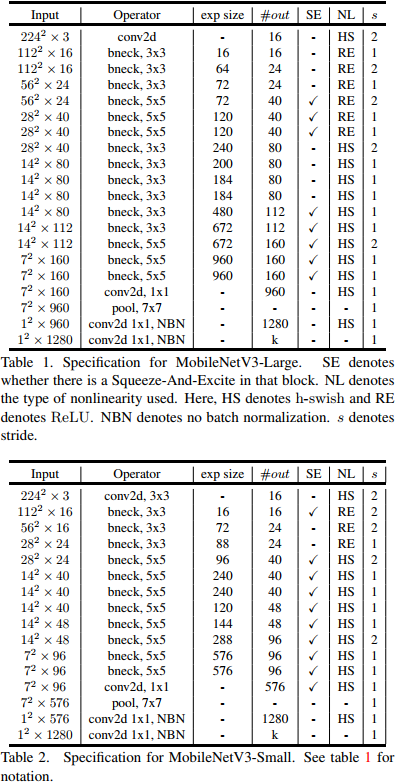前 言:作为当前先进的深度学习目标检测算法YOLOv5,已经集合了大量的trick,但是还是有提高和改进的空间,针对具体应用场景下的检测难点,可以不同的改进方法。此后的系列文章,将重点对YOLOv5的如何改进进行详细的介绍,目的是为了给那些搞科研的同学需要创新点或者搞工程项目的朋友需要达到更好的效果提供自己的微薄帮助和参考。
解决问题:YOLOv5主干特征提取网络采用C3结构,带来较大的参数量,检测速度较慢,应用受限,在某些真实的应用场景如移动或者嵌入式设备,如此大而复杂的模型时难以被应用的。首先是模型过于庞大,面临着内存不足的问题,其次这些场景要求低延迟,或者说响应速度要快,想象一下自动驾驶汽车的行人检测系统如果速度很慢会发生什么可怕的事情。所以,研究小而高效的CNN模型在这些场景至关重要,至少目前是这样,尽管未来硬件也会越来越快。本文尝试将主干特征提取网络替换为更轻量的MobileNet网络,以实现网络模型的轻量化,平衡速度和精度。
原理:
论文地址:https://arxiv.org/abs/1905.02244.pdf
代 码:https://github.com/LeBron-Jian/DeepLearningNote
MobileNet V3 相关技术如下:
- 1,用 MnasNet 搜索网络结构
- 2,用 V1 的深度可分离
- 3,用 V2 的倒置残差线性瓶颈结构
- 4,引入 SE模块
- 5,新的激活函数 h-swish(x)
- 6,网络搜索中利用两个策略:资源受限的 NAS 和 NetAdapt
- 7,修改 V2 最后部分减小计算

方 法:
第一步修改common.py,增加MobileNetV3模块。部分代码如下。
class StemBlock(nn.Module):
def __init__(self, c1, c2, k=3, s=2, p=None, g=1, act=True):
super(StemBlock, self).__init__()
self.stem_1 = Conv(c1, c2, k, s, p, g, act)
self.stem_2a = Conv(c2, c2 // 2, 1, 1, 0)
self.stem_2b = Conv(c2 // 2, c2, 3, 2, 1)
self.stem_2p = nn.MaxPool2d(kernel_size=2, stride=2, ceil_mode=True)
self.stem_3 = Conv(c2 * 2, c2, 1, 1, 0)
def forward(self, x):
stem_1_out = self.stem_1(x)
stem_2a_out = self.stem_2a(stem_1_out)
stem_2b_out = self.stem_2b(stem_2a_out)
stem_2p_out = self.stem_2p(stem_1_out)
out = self.stem_3(torch.cat((stem_2b_out, stem_2p_out), 1))
return out
class h_swish(nn.Module):
def __init__(self, inplace=True):
super(h_swish, self).__init__()
self.sigmoid = h_sigmoid(inplace=inplace)
def forward(self, x):
y = self.sigmoid(x)
return x * y
class SELayer(nn.Module):
def __init__(self, channel, reduction=4):
super(SELayer, self).__init__()
self.avg_pool = nn.AdaptiveAvgPool2d(1)
self.fc = nn.Sequential(
nn.Linear(channel, channel // reduction),
nn.ReLU(inplace=True),
nn.Linear(channel // reduction, channel),
h_sigmoid()
)
def forward(self, x):
b, c, _, _ = x.size()
y = self.avg_pool(x)
y = y.view(b, c)
y = self.fc(y).view(b, c, 1, 1)
return x * y
class conv_bn_hswish(nn.Module):
"""
This equals to
def conv_3x3_bn(inp, oup, stride):
return nn.Sequential(
nn.Conv2d(inp, oup, 3, stride, 1, bias=False),
nn.BatchNorm2d(oup),
h_swish()
)
"""
def __init__(self, c1, c2, stride):
super(conv_bn_hswish, self).__init__()
self.conv = nn.Conv2d(c1, c2, 3, stride, 1, bias=False)
self.bn = nn.BatchNorm2d(c2)
self.act = h_swish()
def forward(self, x):
return self.act(self.bn(self.conv(x)))
def fuseforward(self, x):
return self.act(self.conv(x))
class MobileNetV3_InvertedResidual(nn.Module):
def __init__(self, inp, oup, hidden_dim, kernel_size, stride, use_se, use_hs):
super(MobileNetV3_InvertedResidual, self).__init__()
assert stride in [1, 2]
self.identity = stride == 1 and inp == oup
if inp == hidden_dim:
self.conv = nn.Sequential(
# dw
nn.Conv2d(hidden_dim, hidden_dim, kernel_size, stride, (kernel_size - 1) // 2, groups=hidden_dim,
bias=False),
nn.BatchNorm2d(hidden_dim),
h_swish() if use_hs else nn.ReLU(inplace=True),
# Squeeze-and-Excite
SELayer(hidden_dim) if use_se else nn.Sequential(),
# Eca_layer(hidden_dim) if use_se else nn.Sequential(),#1.13.2022
# pw-linear
nn.Conv2d(hidden_dim, oup, 1, 1, 0, bias=False),
nn.BatchNorm2d(oup),
)
else:
self.conv = nn.Sequential(
# pw
nn.Conv2d(inp, hidden_dim, 1, 1, 0, bias=False),
nn.BatchNorm2d(hidden_dim),
h_swish() if use_hs else nn.ReLU(inplace=True),
# dw
nn.Conv2d(hidden_dim, hidden_dim, kernel_size, stride, (kernel_size - 1) // 2, groups=hidden_dim,
bias=False),
nn.BatchNorm2d(hidden_dim),
# Squeeze-and-Excite
SELayer(hidden_dim) if use_se else nn.Sequential(),
# Eca_layer(hidden_dim) if use_se else nn.Sequential(), # 1.13.2022
h_swish() if use_hs else nn.ReLU(inplace=True),
# pw-linear
nn.Conv2d(hidden_dim, oup, 1, 1, 0, bias=False),
nn.BatchNorm2d(oup),
)
def forward(self, x):
y = self.conv(x)
if self.identity:
return x + y
else:
return y
第二步:将yolo.py中注册模块。
if m in [Conv,MobileNetV3_InvertedResidual,ShuffleNetV2_InvertedResidual, ]:
第三步:修改yaml文件
backbone:
# MobileNetV3-large
# [from, number, module, args]
[[-1, 1, conv_bn_hswish, [16, 2]], # 0-p1/2
[-1, 1, MobileNetV3_InvertedResidual, [ 16, 16, 3, 1, 0, 0]], # 1-p1/2
[-1, 1, MobileNetV3_InvertedResidual, [ 24, 64, 3, 2, 0, 0]], # 2-p2/4
[-1, 1, MobileNetV3_InvertedResidual, [ 24, 72, 3, 1, 0, 0]], # 3-p2/4
[-1, 1, MobileNetV3_InvertedResidual, [ 40, 72, 5, 2, 1, 0]], # 4-p3/8
[-1, 1, MobileNetV3_InvertedResidual, [ 40, 120, 5, 1, 1, 0]], # 5-p3/8
[-1, 1, MobileNetV3_InvertedResidual, [ 40, 120, 5, 1, 1, 0]], # 6-p3/8
[-1, 1, MobileNetV3_InvertedResidual, [ 80, 240, 3, 2, 0, 1]], # 7-p4/16
[-1, 1, MobileNetV3_InvertedResidual, [ 80, 200, 3, 1, 0, 1]], # 8-p4/16
[-1, 1, MobileNetV3_InvertedResidual, [ 80, 184, 3, 1, 0, 1]], # 9-p4/16
[-1, 1, MobileNetV3_InvertedResidual, [ 80, 184, 3, 1, 0, 1]], # 10-p4/16
[-1, 1, MobileNetV3_InvertedResidual, [112, 480, 3, 1, 1, 1]], # 11-p4/16
[-1, 1, MobileNetV3_InvertedResidual, [112, 672, 3, 1, 1, 1]], # 12-p4/16
[-1, 1, MobileNetV3_InvertedResidual, [160, 672, 5, 1, 1, 1]], # 13-p4/16
[-1, 1, MobileNetV3_InvertedResidual, [160, 960, 5, 2, 1, 1]], # 14-p5/32 原672改为原算法960
[-1, 1, MobileNetV3_InvertedResidual, [160, 960, 5, 1, 1, 1]], # 15-p5/32
]
结 果:本人在多个数据集上做了大量实验,针对不同的数据集效果不同,map值有所下降,但是权值模型大小降低,参数量下降。
预告一下:下一篇内容将继续分享网络轻量化方法的分享。有兴趣的朋友可以关注一下我,有问题可以留言或者私聊我哦
PS:干网络的替换不仅仅是适用改进YOLOv5,也可以改进其他的YOLO网络以及目标检测网络,比如YOLOv4、v3等。
最后,希望能互粉一下,做个朋友,一起学习交流。
版权归原作者 人工智能算法研究院 所有, 如有侵权,请联系我们删除。